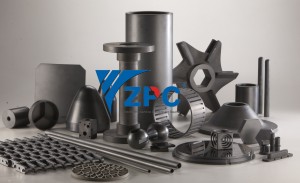Silicon carbide behaves almost like a diamond. It is not only the lightest, but also the hardest ceramic material and has excellent thermal conductivity, low thermal expansion and is very resistant to acids and lyes.
With silicon carbide ceramics the material properties remain constant up to temperatures above 1,400°C. The high Young’s modulus > 400 GPa ensures excellent dimensional stability. These material properties make silicon carbide predestined for use as a construction material. Silicon carbide masters corrosion, abrasion and erosion as skillfully as it stands up to frictional wear. Components are used in chemical plants, mills, expanders and extruders or as nozzles, for example.
“The variants SSiC (sintered silicon carbide) and SiSiC (silicon infiltrated silicon carbide) have established themselves. The latter is particularly suitable for the production of complex large-volume components.”
Silicon carbide is toxicologically safe and can be used in the food industry. Another typical application for silicon carbide components is dynamic sealing technology using friction bearings and mechanical seals, for instance in pumps and drive systems. Compared to metals, silicon carbide enables highly economical solutions with longer tool life when used with aggressive, high-temperature media. Silicon carbide ceramics are also ideal for use in demanding conditions in ballistics, chemical production, energy technology, paper manufacturing and as pipe system components.
Reaction bonded silicon carbide, also known as siliconized silicon carbide or SiSiC, is a type of silicon carbide that is manufactured by a chemical reaction between porous carbon or graphite with molten silicon. Due to the left over traces of silicon, reaction bonded silicon carbide is often referred to as siliconized silicon carbide, or its abbreviation SiSiC.
If pure silicon carbide is produced by sintering of silicon carbide powder, it usually contains traces of chemicals called sintering aids, which are added to support the sintering process by allowing lower sintering temperatures. This type of silicon carbide is often referred to as sintered silicon carbide, or abbreviated to SSiC.
The silicon carbide powder is gained from silicon carbide produced as described in the article silicon carbide.
(Viewed from: CERAMTEC)caroline@rbsic-sisic.com
Post time: Nov-12-2018
